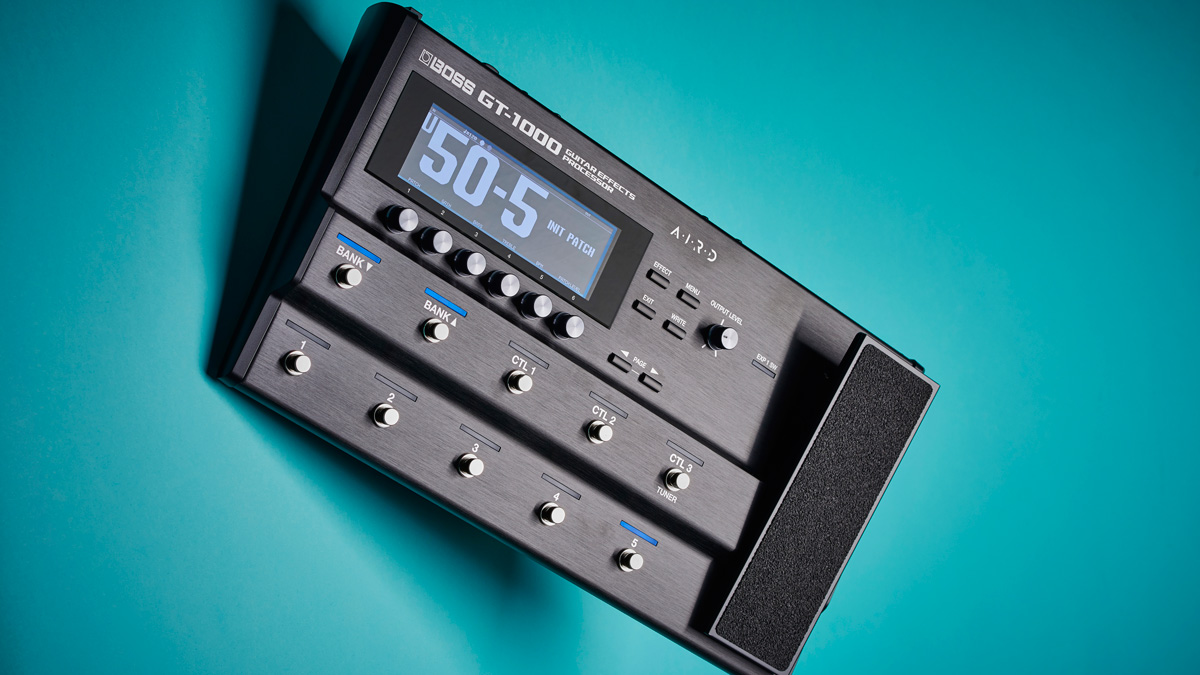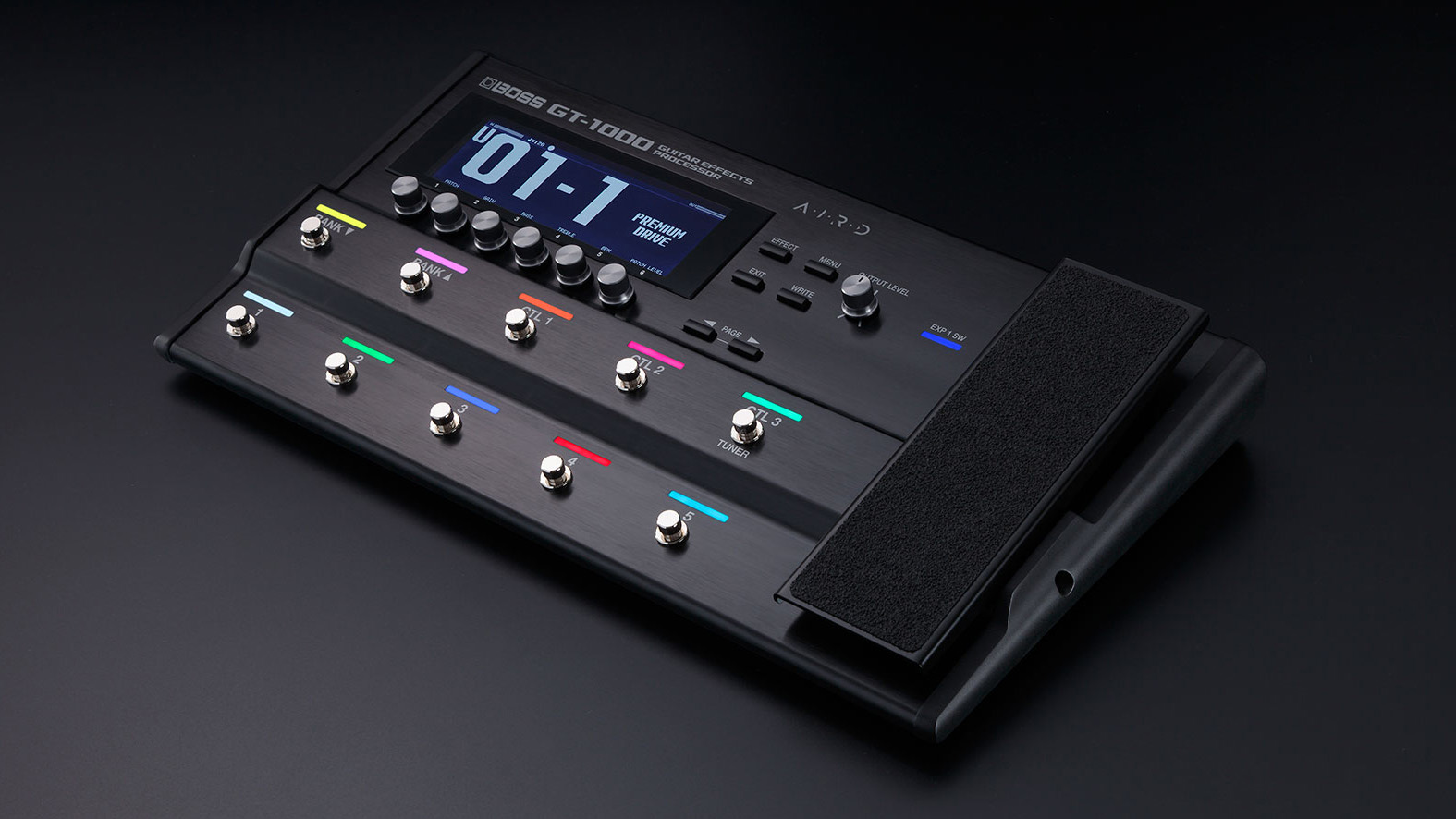MusicRadar Verdict
While it's not the easiest multi-effects to get to grips with, Boss's latest is the company's best yet, and a worthy competitor to Fractal and Line 6.
Pros
- +
Impressive amp models. Huge range of effects. Rock-solid build quality.
Cons
- -
Not particularly beginner-friendly. The patch-based system won't be for everyone.
MusicRadar's got your back
Having learned the lessons of the first wave of digital modelling, several gear giants have re-emerged on the scene with flagship floor modellers.
Coincidentally, this comes just after the tech-metal crowd spent the better part of a decade rehabilitating the image of digital modelling with the Axe-Fx and Kemper. The Boss GT-1000 is Roland’s upmarket multi-effects pedal attempt to bring the Boss brand back into that conversation in style. After the success of the DD-500, RV-500 and MD-500 units, a floorboard combining the three should be a no-brainer. So then, does the GT-1000 deliver?
Physically, it’s a beast. Sleek and modern, Boss’s latest looks like it would survive a fall down a flight of stairs. To the rear, there’s the usual array of inputs and outputs, including a USB recording out and an input for an additional expression pedal. There are jacks to insert two mono pedals, or one stereo external pedal. There’s also a nifty send to allow for amp channel-switching.
When the unit first powers on, there’s a simple screen that can be toggled to show just the patch name, the functions of all the footswitches, or the signal chain of the current patch, via the page buttons. In terms of editing, however, it’s not the most intuitive. In a first for the current generation of modellers, we had to reach for the manual to work out how to start editing the blocks.
Unlike other units that use the model of a signal chain, which you hang every effect in a bank off, the GT-1000 instead treats a bank as a set of completely isolated chains, which means that when you switch between patches in a bank, you’re not just, say, turning off a ‘Tube Screamer’, but you are switching to an entirely different signal chain that doesn’t have a gain block in it. This is actually a familiar conceptual pattern in higher-end gear, and in old rack-style signal processing, but in terms of being beginner-friendly, it’s a step back compared with the strides taken in modern user interface design.

Sounds-wise, the 32-bit, 96khz sampling finds the GT-1000 punching above its weight in terms of clarity and headroom, and the amps certainly feel the benefit of this extra heft. The clean tones are rich and full, though modellers have been able to do pristine amps well for some time now.
Finding a Rectifier model, there’s a sense of the headroom offered by a decent high-gain amp, as well as the saturation you’d expect. Rolling back the bass, we’re able to dig in and get some solid chug out of the GT. Happily, we can report there’s also none of the dreaded ‘fizz’.
On the effects side, there’s a wealth of modulations, delays, reverbs and drives, with a useful second view on the effect selection screen, allowing you to see more clearly the parameters on offer in the effect you’re auditioning.
One of the benefits of the patch system is assembling complicated presets - say, a simple drive patch versus a clean patch with modulation and reverb. This is all the more useful when you consider the brilliant effects on offer. As always, we’re easily swayed by chains that contain stereo delay, reverb and a touch of stereo chorus. For each patch, there are also two assignable blocks that can be toggled on and off via the CTL switches. This could allow you to switch to the gain channel of a simulated amp, which adds more ad-hoc flexibility to each patch.
With a smorgasbord of units now available at a plethora of price points, the difficult thing these days isn’t about being able to find a floorboard that works for you. Rather, it’s in the details - do you need to rely on the stock impulse responses? Do you even need amp simulation? Do you mainly use bread-and-butter effects, or do you like to walk on the more experimental side?
In bringing its Boss effects expertise to the table, it should come as no surprise that this is where the GT-1000 shines. The main difference, compared with its competitors, is how you assemble and program presets. If you run a larger, more traditional pedalboard, perhaps the so-called ‘Bossfecta’ of the MD, RV and DD 500-series units would provide more flexibility, but for most players, the GT-1000 is a highly practical solution.
- The best Boss GT-1000 deals online right now
Alex Lynham is a gear obsessive who's been collecting and building modern and vintage equipment since he got his first Saturday job. Besides reviewing countless pedals for Total Guitar, he's written guides on how to build your first pedal, how to build a tube amp from a kit, and briefly went viral when he released a glitch delay pedal, the Atom Smasher.
“KIKI BOY 2025”: Frank Ocean appears to be teasing something... or other
“This is great. I knew I was getting to them! I’m so happy. It’s such a good feeling”: Spotify bites back at Kate Nash
“The included sample content is not only unique but sonically amazing, as it always was”: Spitfire Audio BBC Radiophonic Workshop review











